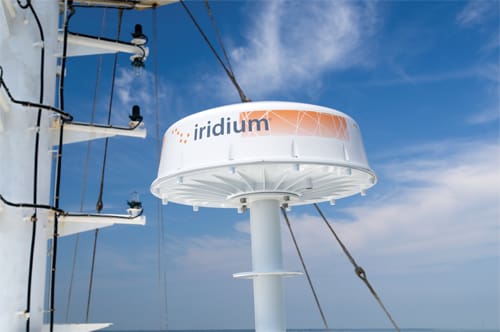First announced by the Motorola Corporation in 1990 to fanfare and some skepticism, the Iridium satellite communications system has provided 14 years of reliable, if somewhat expensive, communications to mobile users the world over, including many voyagers. Current developments and near future upgrades promise to make it a serious contender for years to come. The outlook wasn’t always so rosy for the low earth orbit (LEO) satellite system, however.
When the Motorola Corporation first announced the 77-spacecraft Iridium satellite communications system it seemed outlandishly, possibly even impossibly high tech. (The name Iridium was chosen because its atomic number is 77; the number of spacecraft was later reduced to 66 satellites, but Motorola wisely declined to rename the system for element number 66: dysprosium) Some observers questioned how well Iridium technology would work, or even if it would work at all. Even though constellations of satellites had been developed before (e.g. GPS), Iridium was more technically challenging than anything that came before. Instead of operating simply as “bent pipes,” that is, reradiating any signals they receive from the ground, Iridium satellites transmit sideways, sending signals to each other in space. With this arrangement, users on the surface need not be near an earth station to get their phone call switched into the worldwide phone system, the call can be skipped across satellites until it reaches a satellite in sight of an earth station where it can then be downloaded.
This capability gives the Iridium system true worldwide coverage. This impressive in-space network also delayed the development of the system and drove up the price. By the time the system was declared operational in 1998, the worldwide expansion of terrestrial cell phone networks had already grabbed a good deal of the projected market for Iridium. Motorola was faced with carrying a multi-billion dollar system with only a fraction of the customers needed to make it pay. The company declared bankruptcy, and even floated the idea of “de-orbiting” the satellites — lowering the satellites’ orbit sufficiently so that atmospheric drag would cause them to slow further and burn up on re-entry.
Meanwhile, there was one Iridium customer with deep pockets and some political power: the Pentagon. The U.S. military saw the benefit of a backup worldwide satellite communications network. Accordingly, a small company was assembled to buy the $6 billion dollar investment for roughly $25 million. This new venture, which operates the system today, is called Iridium Communications Inc., and is based in McLean, Va.
In addition to the original handheld satellite phones, in 2007 Iridium introduced a marine satellite terminal called OpenPort. With an antenna roughly the size of a radar radome, but with no moving parts, and weighing about 24 pounds, OpenPort provides users with multiple telephone lines and data capability.
With different communication choices, commercial users like merchant ships, fishing vessels, etc., have to choose what communication channel to use. A vessel’s location, however, can help determine which is the most cost efficient method — close to shore a vessel can use a cell phone; in certain shipping lanes, it can use a geosynchronous satellite service; in the Southern Ocean, the only options are likely to be HF SSB or Iridium. An important piece of gear on a vessel needing to juggle these options is a network management device. This box looks at the ship’s position and automatically chooses the least cost alternative communications solution.
In the past, generally only large ships had this routing technology. Recently KVH Industries and Iridium announced a combined KVH/Iridium system. KVH will offer an integrated service package that combines its mini-VSAT Broadband service with the Iridium OpenPort broadband service. The integrated shipboard system will use common belowdecks user interface equipment for voice and data connections, combining the Iridium OpenPort and KVH TracPhone V3 or V7 terminals. KVH’s CommBox shipboard network management tool will automatically select the mini-VSAT Broadband service or the Iridium OpenPort service using intelligent least-cost routing software. If mini-VSAT Broadband service is ever unavailable, the system is designed to immediately switch over to the Iridium OpenPort service without operator intervention. According to KVH, the Iridium OpenPort connection can also serve as a means to access the mini-VSAT Broadband terminal remotely as well as other shipboard maintenance and calibration equipment. And though you probably won’t be putting this communications package aboard your 24-foot pocket cruiser, the OpenPort/KVH Tracphone V3 setup should fit on most boats in the 40-foot and up range.
The Iridium system should have even greater capabilities to come. In 2015, Iridium is scheduled to launch a new generation of Iridium satellites. This new crop of spacecraft, which Iridium is calling NEXT, will continue with the 66-LEO satellite constellation, with a projected six in-orbit spares and nine graound spares. Having a few spares is a good idea given the 2009 in-orbit collision between an Iridium satellite and a derelict Russian satellite, Cosmos 2251. The hypervelocity collision destroyed both spacecraft (the closing speed of the two spacecraft was calculated by one British scientist at 26,000 miles per hour). With its in-orbit spares, Iridium controllers moved a replacement satellite into the place of the destroyed satellite.
The NEXT satellites have been designed with upgraded data capability: 1.5 Mbps on L-band and up to 8 Mbps on high speed Ka-band, compared to the current constellation’s capability of 128 kbps.

